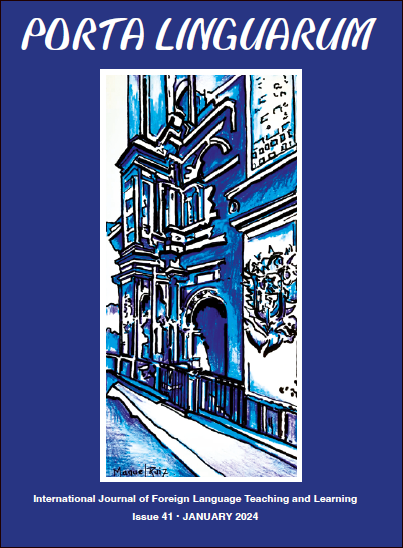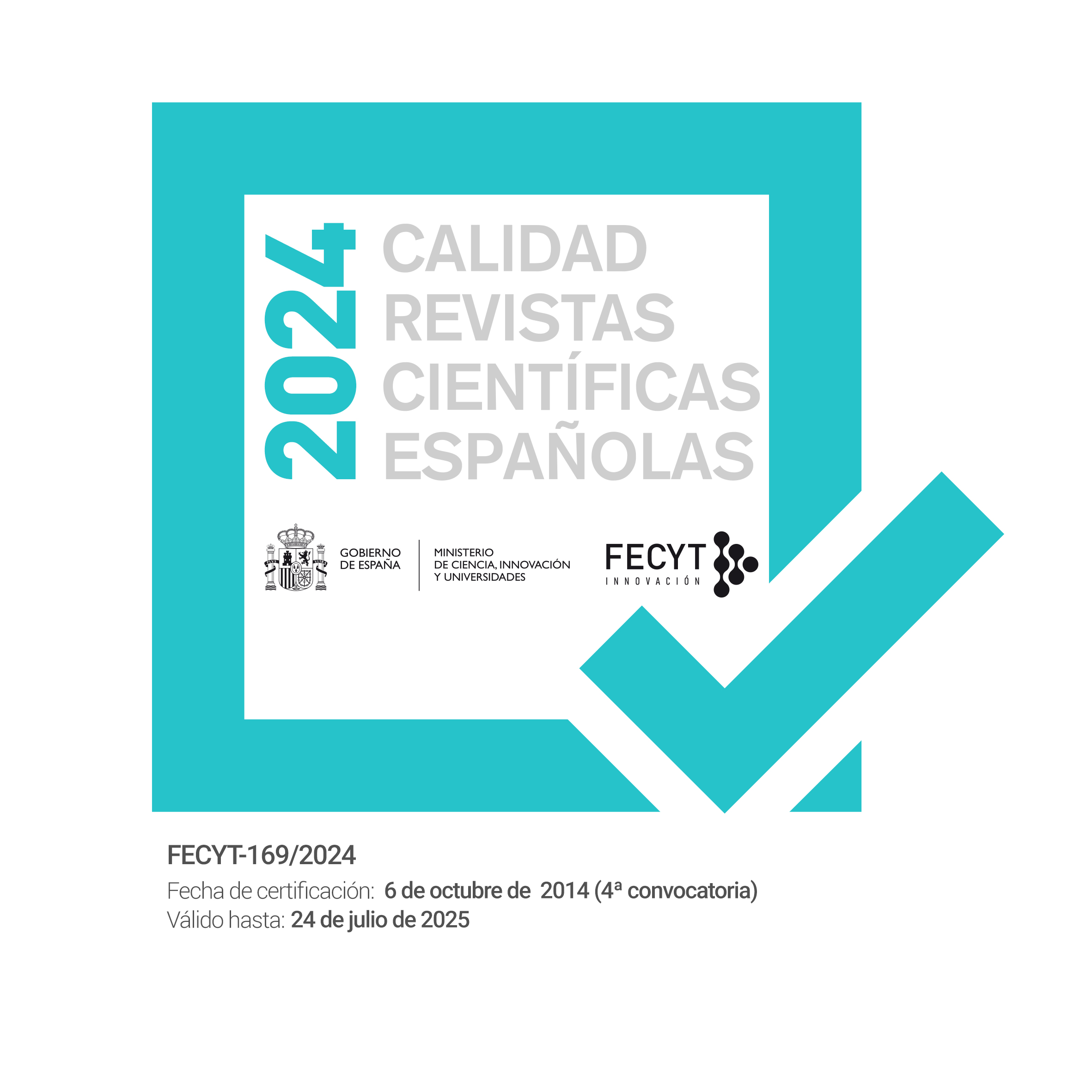Estrategias de aprendizaje de vocabulario de los estudiantes universitarios: El caso de los estudiantes del año preparatorio y de la carrera de inglés
DOI:
https://doi.org/10.30827/portalin.vi41.24321Palabras clave:
estrategias de aprendizaje de vocabulario, aprendizaje y adquisición de vocabulario, estudiantes universitariosResumen
Las estrategias de aprendizaje de vocabulario juegan un papel importante en el aprendizaje y la adquisición del idioma inglés. Este estudio investiga las estrategias de aprendizaje de vocabulario (VLS) que usan los estudiantes universitarios mientras aprenden nuevas palabras y las razones del uso y no uso de algunas VLS notables. Es un intento de averiguar si los VLS difieren entre los niveles universitarios. Un cuestionario de estrategias de aprendizaje de vocabulario de escala Likert de 5 y una entrevista semiestructurada administrada a 82 estudiantes universitarios (es decir, 52 estudiantes de inglés de primer año (EFL) y 32 estudiantes del decanato del año preparatorio (PYD)). Los resultados mostraron que los estudiantes de EFL y PYD comparten aproximadamente la misma cantidad de VLS, pero el uso frecuente de sus estrategias es diferente. Mientras que los estudiantes de EFL utilizan principalmente estrategias metacognitivas para aprender nuevas palabras, los estudiantes de PYD utilizan estrategias de determinación con mayor frecuencia. Los resultados indicaron que el enriquecimiento del léxico mental y la autonomía en el aprendizaje del idioma son las principales razones para utilizar algunos VLS. Además, la principal razón para no usar algunos VLS es la falta de familiaridad con esos VLS.
Descargas
Citas
Al Fraidan, A., & Al-Khalaf, K. (2012). Test-taking strategies of Arab EFL learners on multiple choice Tests. International Education Studies, 5(4): 80-85.
Al Fraidan, A. (2010). Test-Taking Strategies Of EFL Saudi University Level Learners on Two Varieties of Gap-Filling Vocabulary Achievement Tests. Lap Lambert
Al-Buainain, H. (2010). Language learning strategies employed by English majors at Qatar University: Questions and Queries. 4(2): 92-120.
Al-Harthi, T. (2007). Vocabulary problems and strategies of Saudi EFL writers at teachers college. MA dissertation, University of Essex, UK.
Aljdee, A. A. (2011). The relationship between vocabulary learning strategies and vocabulary knowledge. Special Issue for the Nile TESOL Skills Conference Proceedings, pp. 2-170.
Al-Khasawneh, F. M. (2012). Vocabulary learning strategies: a case of Jordan University of Science and Technology. English for Specific Purposes World, 12(34).
Al-Nujaidi, A. H. (2000). Vocabulary learning strategies Of Saudi first year university students. unpublished MA Thesis, Colorado State University, USA.
Al-Nujaidi, A. H. (2003). The relationship between vocabulary size, reading strategies, and reading comprehension of EFL learners in Saudi Arabia. MA. Thesis Oklahoma State University, USA.
AL-Qahtani, M. (2005). The use of vocabulary learning strategies By EFL learners at three different educational levels. PhD Thesis, University of Essex, UK.
Alyami, S. (2011). Vocabulary learning strategies of Saudi EFL majors of different gender, year and proficiency: use and reasons for use. PhD thesis. University of Essex, UK.
Amirian, S. R., & Heshmatifar, Z. (2013). A survey on vocabulary learning strategies: a case of Iranian EFL university students. Journal of Language Teaching and Research 4(3): 636-641.
Anderson, N. J. (2005). L2 strategy research. In: E Hinkel (Ed) Handbook o f research in second language teaching and learning. Mahwah, NJ: Lawrence Erlbaum Associates, pp. 757-772.
Askar, W. A. (2014). A survey on the use of vocabulary learning strategies by ELT and ELL students of Duhok University in northern Iraq. Available at: http://library.neu.edu.tr/neutez/6343844088.pdf (accessed June 2021)
Augustyn, P. (2013). No dictionaries in the classroom: translation equivalents and vocabulary acquisition. International Journal of Lexicography: 26(3), 362–385.
Beglar, D. (2000). Estimating vocabulary size. Shiken: JALT Testing & Evaluation SIG Newsletter: 4(1), 2-4.
Catalán, R. M. (2003). Sex differences in L2 vocabulary learning strategies. International journal of Applied Linguistics: 13(1), 54-77.
Chamot, A. U. (2004). Issues in language learning strategy research and teaching. Electronic Journal of Foreign Language Teaching: 1(1), 14-26.
Chamot, A.U., & Kupper, L. (1989). Learning strategies in foreign language instruction. Foreign Language Annals: 22(1) 246-254.
Cohen, A. D. (1996). Second language learning and use strategies: clarifying the issues. CARLA Working Paper Series #3. The University of Minnesota, Minneapolis, MN.
Cohen, A. D. (2011) Second language learner strategies. Handbook of research in second language teaching and learning: 2, 681-698.
Easterbrook, R. M. (2013). The process of vocabulary learning: vocabulary learning strategies and beliefs about language and language learning. PhD Thesis, The University of Canberra.
Gang, X. U. (2014). A study on english vocabulary learning strategies used by Chinese college students. Studies in Literature and Language: 9(1), 111-116.
Gidey, G. (2008). Vocabulary learning strategy use: the case of high and low achiever students in Gondar College of Teacher Education. MA Thesis, Addis Ababa University.
Gu, P. Y. (2003). Vocabulary learning in a second language: person, task, context and strategies. The Electronic Journal for English as a Second Language, 7(2). Available at: http://www.tesl-ej.org/wordpress/issues/volume7/ej26/ej26a4/?wscr (accessed June 2021)
Hagoort, P., Hald, L., Bastiaansen, M., & Petersson, K. M. (2004). Integration of word meaning and world knowledge in language comprehension. Science: 306, 438-441.
Krashen, S. D. (1975). The critical period for language acquisition. In Aaronson D and Rieber RW(eds) Developmental psycholinguistics and communication disorders. New York: New York Academy of Science, pp. 24-111.
Krashen, S. D. (1985) The Input Hypothesis: Issues and Implications. Addison-Wesley Longman Ltd.
Lawson, M. J., & Hogben, D. (1996). The vocabulary-learning strategies of foreign-language students. Language Learning: 46(1), 101-135.
Lenneberg, E. H. (1967). Biological foundations of language. New York: Wiley.
Liao, Y. F. (2004). A survey study of Taiwan EFL freshmen’s vocabulary learning strategies. Journal of Pingtung Teachers College: 21, 271-288.
l-Khasawneh, A. B. M., & Al-Khasawneh, F. M. (2012). English language earning strategies employed by Jordanian students at Yarmouk University. Language in India, 12(7).
McDermott, J. E. (1999) Implicit and Explicit Learning of Languages. Dialog on Language Instruction: 13(1), 27-44.
Milton, J. ( 2009 ). Measuring Second Language Vocabulary Acquisition. Great Britain : Short Run Press.
Mokhtar, A. A., Rawian, R. M., Yahaya, M. F., & Mohamed, A. R. (2009). Vocabulary learning strategies of adult ESL learners. The English Teacher: 38, 133-145.
Nation, I. S. (2001). Learning vocabulary in another language. Cambridge: Cambridge University Press.
Nirattisai, S. (2014). Vocabulary learning strategies of Thai University. International Journal of English Language Education: 2(1), 273-287.
Nunan, D. (1988) Syllabus Design. Hong Kong: Oxford University Press.
O'Malley, J. M., & Chamot, A. U. (1990). Learning trategies in second language acquisition. USA: Cambridge University Press.
Oxford, R. L., & Cohen, A. D. (1992). Language learning strategies. Applied Language Learning: 3, 1-35.
Oxford, R. L. (1989). Use of Language Learning Strategies: A Synthesis of Studies with Implications for Strategy Training. System: 17(2), 235-247.
Oxford, R. L., & Scarcella, R. C. (1994). Second language vocabulary learning among adults: state of the art in vocabulary instruction. System:22(2), 231-243.
Oxford, R. L., & Crookall, D. (2009). Vocabulary Learning: A Critical Analysis of Techniques. TESL Canada Journal: 7(2), 9-30.
Richards, J. C., & Schmidt, R. (2002). Longman dictionary of language teaching and applied linguistics ( Third ed.). Pearson Education Limited.
Rubin, J. (2013). Teaching Language-Learning Strategies. In Chapelle C (ed) The encyclopedia of applied linguistics. Blackwell Publishing Ltd: Blackwell Publishing Ltd. doi:10.1002/9781405198431.wbeal1165
Saengpakdeejit, R. (2014). Strategies for Dealing with Vocabulary Learning Problems by Thai University Students. Silpakorn University Journal of Social Sciences, Humanities, and Arts, 14(1), 147-167.
Sofian, N. H, & Malakar, S. (2014). Exploring Vocabulary Learning Strategies Used by UPM TESL Undergraduates. Advances in Language and Literary Studies: 5(5). Available at: http://dx.doi.org/10.7575/aiac.alls.v.5n.5p.1 (accessed June 2021)
Schmitt, N. (2000). Vocabulary in Language Teaching. Cambridge: Cambridge University Press.
Schmitt, N. (1997). Vocabulary learning strategies. In (eds.) Schmitt N, and McCarthy M (eds) Vocabulary :Descriptive, acquisition and pedagogy. Cambridge: Cambridge University Press.
Schmitt, N. (2008). Teaching Vocabulary. Pearson Education, Inc. Longman
Schmitt, N., & McCarthy, M. (1997). Vocabulary: Description, acquisition and pedagogy. Cambridge: Cambridge: Cambridge University Press.
Schmitt, N., & Schmitt, D. (2014). A reassessment of frequency and vocabulary size in L2 vocabulary teaching. Language Teaching, 47(4), 484 – 503.
FUNDING INFORMATION:
This work was funded and supported by the Deanship of Scientific Research, Vice Presidency for Graduate Studies and Scientific Research, King Faisal University, Saudi Arabia [Grant No. 4,974].



















